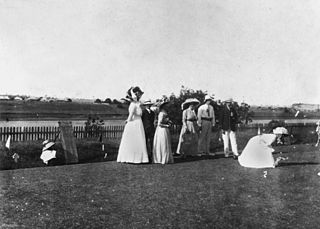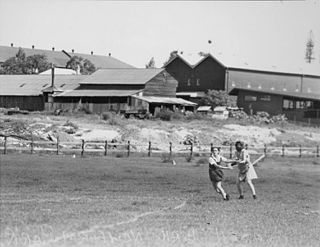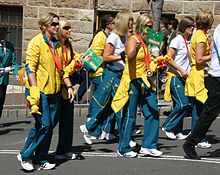
Australia's softball history began in 1939 when Gordon Young, Director of Physical Education in NSW, began to promote the game in schools and colleges. In 1942, during World War II, US army sergeant William Duvernet organised softball as a recreation for US nurses stationed in Victoria. Another American, Mack Gilley, introduced the game to Queensland in 1946. Australia's first inter-state championship was played in Brisbane in 1947 and was won by Victoria. The second national championship was held in Melbourne two years later. It was at this championship that the Australian Softball Federation was formed with Queensland, Victoria, South Australia and New South Wales being the founding members. The other States of Australia have since joined. Eight Australian Championships are now conducted each year – Women's, Men's, Under 23 Women and Men, Under 19 Women and Men, and Under 16 Girls and Boys. Softball has been a major sport in the schools program for some time now and it is estimated that more than 250,000 children play the game each year.

The Gilleys Shield is a trophy symbolising the Open Women's Championship of the Softball Australia organisation. The competition's full name is the Mack Gilley Shield.
The Women's Softball World Cup is a fastpitch softball tournament for women's national teams held historically every four years, now every two years, by the World Baseball Softball Confederation (WBSC). The tournament, originally known as the ISF Women's World Championship, was sanctioned by the International Softball Federation (ISF) until that body's 2013 merger with the International Baseball Federation to create the WBSC. The number of teams in the tournament began at five in its inaugural event in 1965, went to a high of 28 for the 1994 edition, and now the WBSC Code legislates that the maximum number of teams that may participate is 16. There are qualifying tournaments that determine which countries will play at the World Cup.
The Australia women's national softball team, also known as the Aussie Spirit, or the Dingeroos, is the national softball team of Australia. It is governed by Softball Australia and takes part in international softball competitions. They are one of Australia's most successful women's sporting teams on the world stage, and they have achieved outstanding results over the last 3 decades. Alongside the USA team, the Aussie Spirit are the only other team to medal at all 4 Olympics that softball was included as a sport in the Olympics program. At the inaugural Women's Softball World Championship held in Melbourne, 1965. Australia claimed the first ever title, winning Gold and stamped themselves as a pioneer in the sport.
Field hockey has been played by men in Australia since 1901. By 1907, there were clubs in several states including New South Wales, South Australia, Tasmania, and Victoria. Women's field hockey was eventually represented by the Australian Institute of Sport, though the amount of support it received was less than the support the men received. The All Australian Women's Hockey Association was established in 1910 to govern the sport in Australia. in 2000, Women's Hockey Australia merged with the Australian Hockey Association to form Hockey Australia. The game has been played by women on the university and school level. Interstate matches were being played by 1909. The level of play on the interstate level is very high. The Australia women's national field hockey team, established in 1914, has placed highly in many competitions.

While not being urged to avoid competition, women had few opportunities to compete in sport in Australia until the 1880s. After that date, new sporting facilities were being built around the country and many new sport clubs were created. Athletic events were being held in schools in Australia by the early part of the twentieth century. The Glennie School in Toowoomba was one school to host races for girls during their annual girls' sport day. During the 1920s, girls were able to run while wearing bloomers, instead of skirts. The first meeting for women's athletics took place in 1926 and was organised by the NSWAAA. The purpose of the meeting was to determine if it would be possible to send women to compete in the 1928 Summer Olympics based on merit. Only one female athlete was determined to be good enough to send. That was E.F. Robinson. The first women's national athletics body designed to govern the sport in Australia was founded in 1932 and was called the Australian Women's Amateur Athletic Union. It was designed to oversee state organisations in Victoria (1929), Queensland (1921), New South Wales (1932) and South Australia. (1932) The first Australian woman to travel overseas to compete was E.F. Robinson, who went to the 1928 Summer Olympics where she ran in the 100-metres. She came in third and was the only Australian female on the 1928 Australian Olympic team.

The beginning of women's badminton in Australia dates back to the year 1900, when for the first time badminton was played in Australia.

The first women's bowls match played in Australia took place in Stawell, Victoria, in October 1881. The first women's only bowls club was not created for another seventeen years, when the Rainsford Bowls Club was created on 16 December 1898 at the home of J. Rainsford Needham, who lived in Glenferrie, Victoria. The first women's bowls association was created in September 1907. The association was called the Victorian Ladies' Bowling Association, and was created by six Melbourne-based clubs. It was the first women's bowling association created the world.

Croquet has historically been a sport in Australia where men and women were able to compete on a level playing field.

While not being urged to avoid competition, women had few opportunities to compete in sport in Australia until the 1880s. After that point, new sporting facilities were being built around the country and many new sport clubs were created. During the 1900s in Australia, lacrosse became more socially acceptable for women to participate in. Subsequently, female participation rates rose in places like Queensland.
Women's cue sports in Australia is a sporting topic that has received some Australian media coverage since the early 20th century. Coverage began with English billiards and today is more often about the sport of snooker and various pool games such as eight-ball.

In the 1880s in Victoria, there were school competitions for girls involving interschool competitions for rounders, an early form of baseball. The competitions were abandoned in the 1890s. Girls who played rounders/baseball during the 1880s and 1890s were required to wear long sleeved shirts and long skirts. These restricted a player's ability to move.
In Australia, archery is a sport in which men and women compete against each other on an equal playing field. Coed competitions have occurred since Australia's colonial era. An example of one such competition took played in Yandilla, Queensland, in 1878. Women's archery was established in Victoria by the 1870s, mostly in archery clubs. People viewed women's archery as a royal sport during this era and they encouraged women to participate because it did not require women to give up their womanhood in order to compete. Women were members of an archery club in Adelaide by 1870.
During the 1970s and 1980s, Australian women's basketball was successful in terms of attracting participants and having a competitive team on the international stages. This success did not translate into sponsorship and financial support for the sport.
Softball is played in Queensland .
Softball is played in New South Wales, introduced to the state in 1939. By 1984, there were 1,356 registered teams in New South Wales. Players from Australia have been on the men's and women's national team, had AIS scholarships, played at universities in the United States, and professionally in the US, Japan and Europe.
Softball is played in the Australian state of Victoria.
Softball is played in Tasmania. The game was brought to the island during the late 1940s from Melbourne, Victoria. The sport would grow in popularity in Tasmania with 56 teams in 1976 to 216 in 1984. Men's softball is not popular in Tasmania. The first softball only facility was built in Tasmania in 1984.
Softball is played in the Australian Capital Territory. The game was influenced early in its history in the territory by Queanbeyan. There are efforts to increase participation in the sport in the ACT. The territory has won the Gilleys Shield three times in a row. Players from Canberra have been on the national team, held Australian Institute of Sport scholarships and played for American universities.










